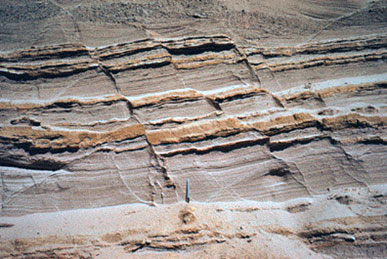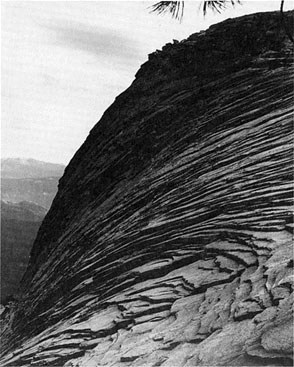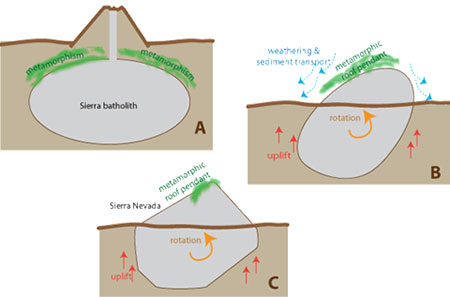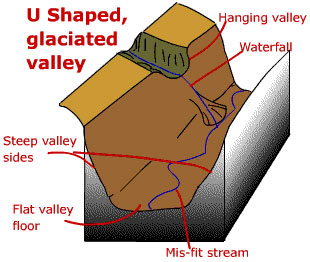Geology and Natural Heritage of the Long Valley Caldera
Recent Geomorphology of the Eastern Sierra Nevada (Particularly Yosemite Valley)
Elizabeth Salter
Abstract
Though the Sierra Nevada Mountains were formed through tectonic activity, their current appearance has largely been the result of fairly recent geomorphology. The granite of the Sierra Nevada Batholith has been exposed through several periods of glaciation, as well as through the interplay of water– and gravity–related weathering. These factors created the “ideally” glaciated Yosemite Valley. Overall, though glaciers are responsible for many of the features of the Sierra Nevada, most glacial action serves to modify features formed by water.
Introduction
A Brief History of Recent Sierran Glaciations
The Sierra Nevada have been affected by many glaciations over the last few million years, though we will examine only those that have occurred fairly recently, from the late Pliocene to the present. The Sierras were not affected by the Great Ice Age, as they were large enough that the glaciers could not cross them. However, they were also large enough to form glaciers of their own, which occurred at the same time as the Ice Age glaciers but were independent of them (Hill 2006). Many of the glaciations that have occurred even in the recent past were close enough together that it is difficult to say where one ends and another begins (Clark and Gillespie 2011) (see Figure 1).
The McGee glaciation occurred 2700-1500 ka during the late Pliocene period (Clark and Gillespie 2011). The evidence of this glaciation is “represented by deeply weathered erratic boulders and diamictons on highland surfaces” (Clark and Gillespie). See Table 1 for a summary of important Sierran glaciations.
The next significant glaciation is the Sherwin, which has been shown to predate the Bishop Tuff and therefore the Long Valley eruption [Clark and Gillespie 2011, from Sharp (1968)]. As shown in Figure 1, the Sherwin Glaciation was not extensive in the context of the entire Sierra Nevada, though it was significant in the Long Valley region. As noted in the caption of Figure 1, the scale of the image makes it difficult to distinguish the various glaciations, or to show the detail of the Sherwin glaciation. However, it is thought that the Sherwin glaciation extended farther than the Tioga or the Tahoe glaciations in localized areas, which is not evident in the figure.
It has been estimated that the Sherwin glaciation occurred 820 ka, during the late Early Pleistocene.
The next significant glaciation is the Tahoe, which is one of four major glaciations of the Sierra Nevada, according to Blackwelder (1931), though several smaller glaciations occurred in the interim between the Sherwin and Tahoe. There is also evidence of an “older Tahoe” glaciation that has not been dated, though it is thought that this period of glaciation is actually independent from the Tahoe glaciation (Clark and Gillespie 2011). The Tahoe glaciation occurred 50–42 ka.
The Tioga glaciation is the next significant glacial event to have occurred, having begun around 25 ka and retreating as recently as 14 ka. There is evidence also of the Tenaya glacier, which took place 31 ka, between the Tahoe and Tioga glaciers (Clark and Gillespie, 2011).
Most recently, the Matthes glaciation occurred during the "Little Ice Age" (Clark and Gillespie, 2011), representing the most recent major glacial advance. There is also some modern glaciation in the Sierras. Hill (2006) estimates that there are 99 glaciers and 398 glacierets in the Sierra Nevada, based on Bill Guyton’s Glaciers of California (1998). The locations of some present-day glaciers in the Sierra Nevada can be found in Figure 1. Note how the majority of the modern glaciers are located in the central and southern part of the range, rather than in the northern part.
Figure 1: Glaciation of the Sierra Nevada. Figure reproduced from Clark and Gillespie, adapted from Warhaftig and Birman, 1965 and Clark, 1995. From Clark and Gillespie: "Late Pleistocene (Tioga) and older glacial deposits are, in general, so similar in extent that they are difficult to distinguish at this scale." Base map: USGS NED dataset (3–s resolution, – 90 m).
Table 1: Significant Glaciations of the Sierra Nevada (figure based on information from Clark and Gillespie, 2011).
Geomorphology of Granite
There are several properties of granite that make it ideal for glaciation and have contributed to the geomorphology of the Sierra Nevada. The first such property is jointing. Because jointing is a regional feature (Hill 2006), joints in the Sierra tend to run either northwest or northeast. Joints running in the same direction are roughly parallel to one another, and the two sets of joints are approximately perpendicular to one another. Joints have a distinctive, "blocky" appearance and are not a result of glaciation. It is thought that the joints must have developed after the Sierra Nevada batholith but "before the extensive weathering period that followed, because the joints themselves are deeply weathered" (Hill 2006). It can therefore be interpreted that joints do not result from glaciation, but are still an important aspect of the geomorphology of the Sierra Nevada (See Figure 2).
According to Hill, sheeting is a local phenomenon rather than a regional one. Again, sheeting is not a glacial feature but has been an important factor in the overall appearance of the Sierra Nevada. It has been proposed that sheeting, or a "leafing away" of exposed granite parallel to the topography, is caused by both the sun and precipitation. The mineral feldspar forms clay when combined with water, swelling when wet and crumbling when dry (Hill 2006). The action of becoming wet and drying, combined with heating and cooling, can soon cause granite to break away in "sheets" that look like an onion peel (see Figure 3). This has lent to some of the more striking features of Yosemite Valley and the Sierra Nevada, including the exfoliation shells of Half Dome.
These two distinctive features of granite have contributed to the geomorphology of the Sierra Nevada. It can be inferred that jointing predates most glaciation, as, according to Hill (and stated earlier in this paper), the joints are deeply weathered and were probably formed early in the history of the batholith. Sheeting, however, may well be a more recent phenomenon, as glaciation would probably erase any traces of sheeting as ice carves through the granite. Thus any previous sheeting would be eliminated during glaciation, and the current exfoliation shells would begin to form after the glaciers receded. This, however, is only a speculative interpretation.
Figure 2: An example of jointing in rock (not specifically in the Sierra Nevada). Image source: http://geoscience.wisc.edu/~chuck/Classes/Mtn_and_Plates/rock_deformation.html.
Figure 3: an example of sheeting (not specifically Sierra Nevada sheeting). Image source: http://www.webpages.uidaho.edu/~simkat/geol345_files/2012lecture6.html.
Geomorphology of the Sierra Nevada Roof Pendants
Not all of the rocks in the Sierra Nevada are granitic. Metamorphosed sedimentary and volcanic rock also exists, and is thought to be the remaining country rock not "digested" by the magmatic batholith. According to Hill, these areas of metamorphic rock in the Sierras are called "roof pendants" because they were suspended from the top of the magma chamber like pendants. In the magma chamber, the sedimentary and volcanic rock was metamorphosed, then later exposed. The changing of these sedimentary and igneous rocks via metamorphosis may not geomorphology per se, but the manner in which the metamorphic rock was later exposed (through weathering) is, and this process does contribute to the current overall composition of the Sierra Nevada (see Figure 4).
Figure 4: Graphic showing the formation of a roof pendant in the Sierra Nevada. Image source: http://www.foothill.edu/fac/klenkeit/virtual/tectonic/process3.php.
The Effects of Glaciation on Yosemite Valley
The Sierra Nevada was formed tectonically, but the mountains visible today were exposed through water, wind, and glaciers. The focus of this portion of the paper is on the effects of glaciation on the appearance of Yosemite Valley, but the formation of the valley was not, in fact, a direct result of glaciation (Hill 2006). Rather, it was originally a river valley, formed by the Merced River, that was later glaciated to yield its present shape. The “V” that the Merced River would have cut through the granite was carved away by glaciers to form the gently sloping "U" shaped valley that it is in the present day. This occurred because glaciers tend to smooth out the sharp angles formed when rivers cut through rock, though they follow the same general path as the river because ice, like water, follows the easiest path downhill. Today, the Merced River meanders through the bottom of Yosemite Valley, again slowly carving a valley like the one that was changed by recent glaciers. Such a river is called a misfit river, because it is too small to have created the valley (scalloway.org.uk).
Well-known features such as Yosemite Falls and Half Dome were shaped through glaciation as well. Yosemite Falls was once a hanging valley, where a smaller glacier joined a larger one (much like a tributary might join a larger river). When the glacier recedes, a stream is frequently left behind that drops down the side of the valley (see Figure 5). Half Dome, too, was shaped by glacial action, as a glacier carved one side, creating the dramatic cliff.
Moraines are also a very important glacial feature, as, according to Gillespie and Clark, they are used to determine glacial history. The age and sources of sediments in moraines can reveal a lot about the glaciers that formed them, so many inferences about the age and scope of a glacier can be drawn.
Figure 5: Diagram depicting a U shaped glacial valley. Notice in particular the formation of a hanging wall when a glacier recedes. Image source: http://www.scalloway.org.uk/phyl12.htm.
Geomorphologic Interactions and Interpretations
The glaciation and weathering in the Sierra Nevada during the last million years have helped to expose and shape the Sierra Nevada Batholith. Water has played an important role in carving valleys and causing the sheeting of granite, as well as weathering existing features. These processes are ongoing, and are aided by the force of gravity. Glaciation is not actively changing the landscape of the Sierra Nevada today (though some small glaciers do exist in the range), though it has contributed to the appearance of the range in recent history. These two factors–water and ice–have interacted in the past to affect present landforms, such as in the formation of the Yosemite Valley.
Works Cited
E. Blackwelder. Pleistocene glaciation in the Sierra Nevada and Basin Ranges. Geol. Soc. Am. Bull., 42 (1931), pp. 865-922
Alan R. Gillespie, Douglas H. Clark. Chapter 34 – Glaciations of the Sierra Nevada, California, USA. Developments in Quaternary Sciences, Volume 15, 2011, Pages 447–462. DOI
Hill, Mary. Geology of the Sierra Nevada, Revised Edition. University of California Press, 2006.
"U–Shaped Valleys." U–Shaped Valleys. Website
[Return to Research Projects] [Return to Sierra Home]





